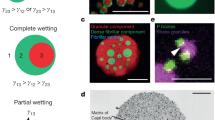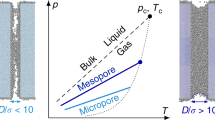Abstract
AN important question for the theory of capillarity is this: Is it necessary, in order to explain the observed phenomena, to conclude that there is, in the surface of a liquid, any differentiation of the molecular arrangements and forces from those prevailing in the interior, of such a nature that there is a skin possessing a tension parallel to the surface? Many writers appear to assume that, because the free energy associated with each unit of area of the surface is most conveniently replaced in calculations by a tension parallel to the surface, there must be some special structure in the surface which produces this tension physically. Although any free energy resident at the surface may mathematically be considered as the product of a “surface tension” and the area, there is no justification in this fact for concluding that the molecular arrangements and forces at the surface resemble those in a stretched membrane. Indeed, probably all attempts made to explain the molecular structure of surfaces, which have assumed such a contractile mechanism, have been complete failures.
This is a preview of subscription content, access via your institution
Access options
Subscribe to this journal
Receive 51 print issues and online access
$199.00 per year
only $3.90 per issue
Buy this article
- Purchase on Springer Link
- Instant access to full article PDF
Prices may be subject to local taxes which are calculated during checkout
Similar content being viewed by others
References
Based on a lecture delivered to the Physical Society of Sheffield, on October 28, 1924.
Works, vol. 1, p. 410. Brit. Ass. Rep., 1881.
Dupre's well-known equation. Equation 3 has been obtained by Edser, and a similar equation is obtainable from Laplace's theory, considering the attractions between particles of liquid and solid, and liquid and liquid.
Phil. Mag. 46, p. 244 (1923).
Phys. Review, 13, p. 273 (1921).
Phil. Mag. 44, p. 1152 (1922).
Rights and permissions
About this article
Cite this article
ADAM, N. The Molecular Mechanism of Capillary Phenomena. Nature 115, 512–513 (1925). https://doi.org/10.1038/115512a0
Issue Date:
DOI: https://doi.org/10.1038/115512a0
Comments
By submitting a comment you agree to abide by our Terms and Community Guidelines. If you find something abusive or that does not comply with our terms or guidelines please flag it as inappropriate.



